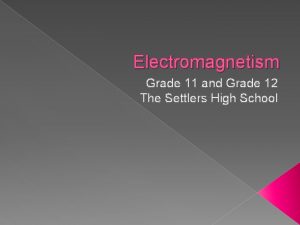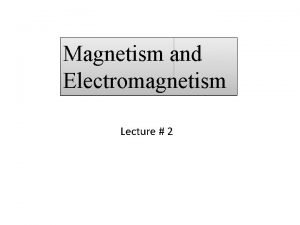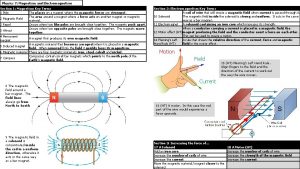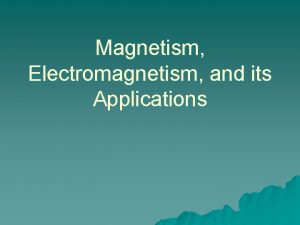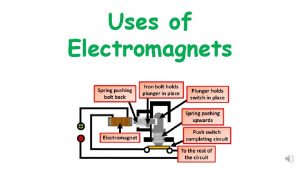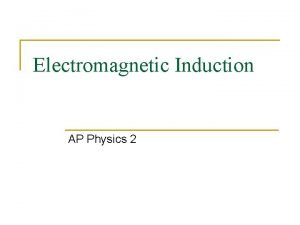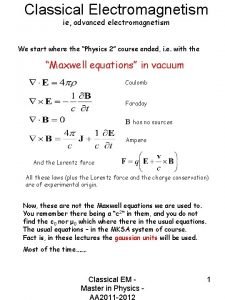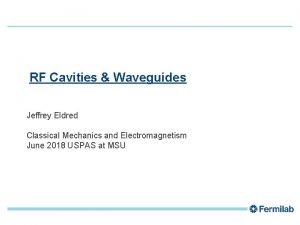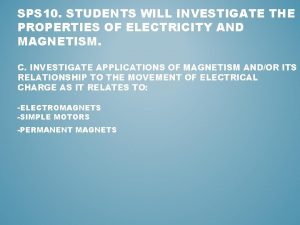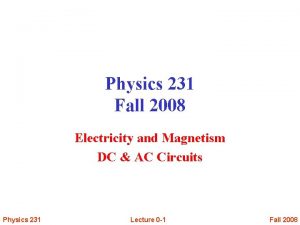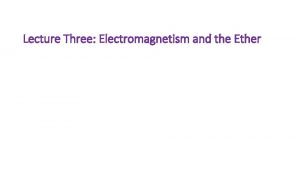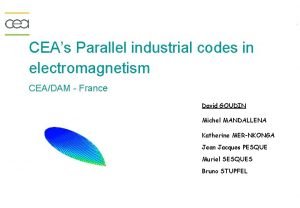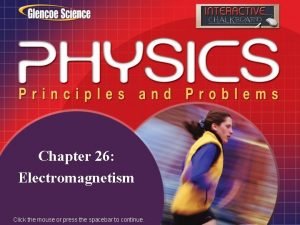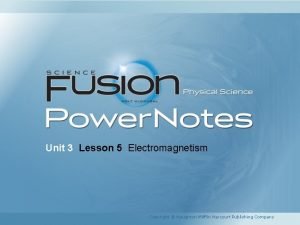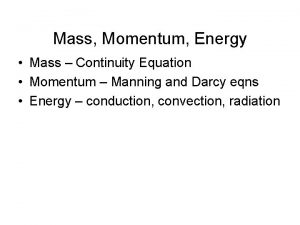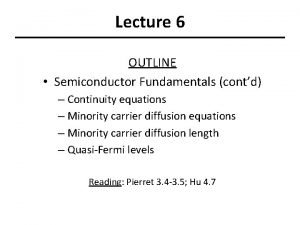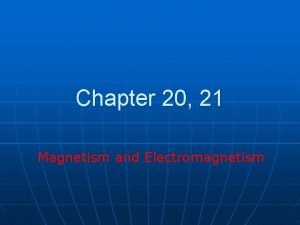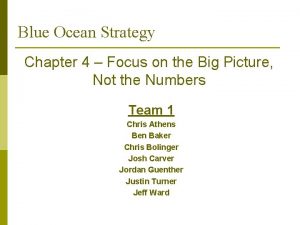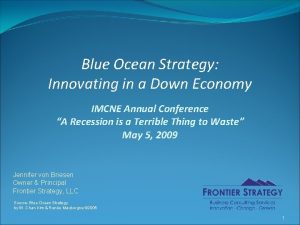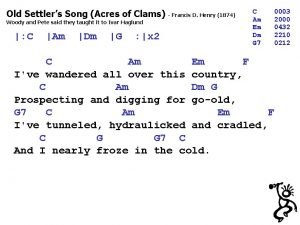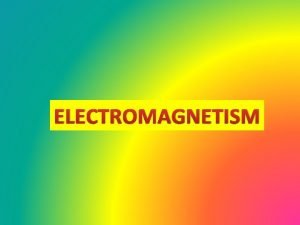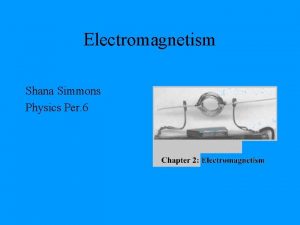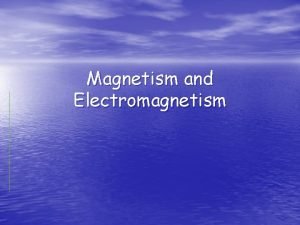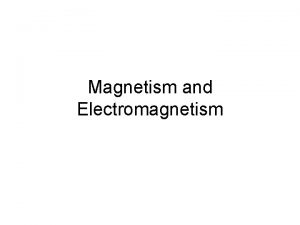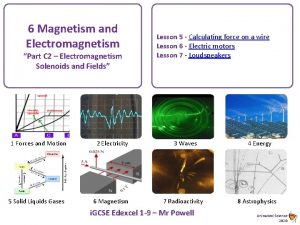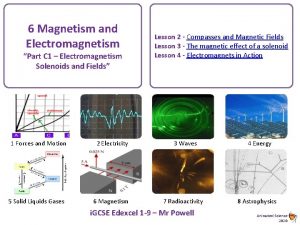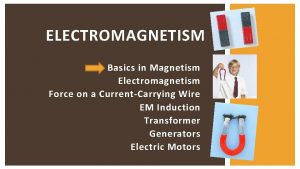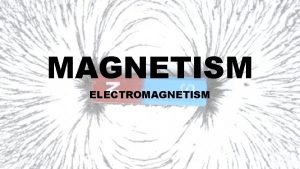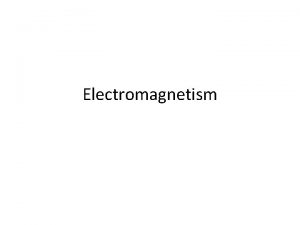Electromagnetism Grade 11 and Grade 12 The Settlers



















































- Slides: 51

Electromagnetism Grade 11 and Grade 12 The Settlers High School

The shapes of magnetic fields � The closer the field lines are to each other the stronger the magnetic field at that point � The field lines run from north to south outside the magnet and from south to north inside the magnet.

Magnetic field about straight conductor There is a magnetic field about a straight currentcarrying conductor. This field consists of concentric circles and can be studied by using iron filings or small compasses as in the sketches below.

Direction of magnetic field about straight conductor Clasp the conductor with the right hand – thumb pointing in the direction of conventional current flow. The fingers now curl in the direction of the magnetic field.

Direction of magnetic field about straight conductors Direct current into page (x in circle) produces a clockwise field. Current out of page (dot in circle) produces an anticlockwise field. Check with right-hand rule. Now see how the fields interact if there are currents in parallel conductors. Currents in same direction – wires expierence a force towards each other. Currents in opposite directions –wires expierence a force away from each other.

Direction of magnetic field about straight parallel conductors Magnetic fields about parallel conductors The field lines add up if they are in same direction resulting in more field lines and so a stronger field. The magnetic field lines subtract if in the opposite direction resulting in less field lines and a weaker field. The wires will experience a force towards a region of lower magnetic field density

Direction of magnetic field about a solenoid A solenoid is just a coil of wire – as in sketch below. Draw this circuit and then draw the magnetic field about the coil. Is there any resemblance to the field about a magnet?

Direction of magnetic field about a solenoid

Right hand solenoid rule – Amperes rule Clasp the solenoid in the right hand – pointing the curled fingers in the direction of the direct current flow. The thumb now points to the North pole of the field about the solenoid. To increase the strength of the magnetic field, you could: wrap more coils in the solenoid; increase the current flowing through the solenoid; and wrap the coils around a magnetic material, for example, a length of iron. The iron core then concentrates the magnetic filed, making it stronger.

Ampere’s Rule for a Solenoid: Grasp the coil in the right hand with the fingers circling the coil in the direction of the conventional current. The extended thumb will point in the direction of the North pole of the core.

Electromagnets A simple electromagnet can be made by winding a length of wire about an iron ( ferromagnetic material) nail and connecting to a battery. Apply the right hand wire rule to identify the N & S poles. N S Each of these smaller nails in turn – also becomes a magnet.

Construction of an Electromagnet When we place an iron bar, called an iron core, in the solenoid, it can be magnetised temporarily. If the current in the solenoid is switched off, the magnetic field around the solenoid no longer exists and in turn the iron core loses its magnetism. .

The core must be made of soft iron, so that it can lose its magnetism immediately the current is switched off in the solenoid. If a hard iron, such as steel, is used it will become a permanent magnet when magnetised by the solenoid. This means that when the current in the solenoid is switched off the core keeps its magnetism

Uses electromagnets

The electromagnetic force � A current carrying conductor that is placed in a magnetic field will experience a force � The magnetic field of the current carrying wire is a set of concentric rings and the magnetic field of the magnet is a set of parallel lines that run from north to south.

Flemmings Left hand motor rule The concentric circular field about the conductor, interacts with the permanent field between the magnets to form this resulting magnetic field. This now produces motion of the conductor in the direction of F - as a result of the strengthening and weakening of the resultant fields to the left & right of the conductor – as seen in the second sketch. The force is in the direction of lower Strengthening of magnetic field density Field between resultant field magnets. Field about conductor Weakening of field

Left hand motor rule Thrust Magnetic field Current This rule is used to establish the direction of movement of the current carrying conductor in the magnetic field. Note: The first finger points in the direction of the magnetic field, the middle finger points in the direction of the conventional current flow and the thumb in the direction of the thrust of the conductor. Now apply this rule to this sketch.

Example An experiment, to find the effect of a magnetic field on a current-bearing conductor, is set up as in the photograph. .

When the switch is closed, a current flows through the metal swing hanging in the magnet. a) In which direction will the metal swing experience a force: into or out of the magnet? b) Name and describe the rule you used to determine the direction of the force experienced by the metal swing

Moving charge in a magnetic field experiences a force � The force that acts on the wire is actually acting on the moving electrons in the wire. Therefore, if a freely moving charged particle moves in a magnetic field it will experience a force The direction of movement of the charge, q, is indicated by the arrow labelled v, and the force is indicated with the arrow labelled, F. The field is going Into the page (X) �

Cathode Ray Tube(CRT) � The movement of a charged particle in a magnetic field has a useful application in the screens of our television sets. The screen works by using a (CRT). The cathode ray tube is essentially made up of a stream of electrons, which deflects in the presence of a magnetic, or sometimes an electric, field. Inside the tube electrons are directed onto the screen, to produce an image. Modern TVs do not use cathode ray tubes.


Magnetic force A charge q moving with velocity v perpendicular to a magnetic field feels a maximum magnetic force F=qv. B � The force is perpendicular to v and to B ( Flemming’s left hand motor rule) �

The magnitude of the force depends on: the magnitude of the charge, Q – the magnitude of the force and the charge are directly proportional, which may be represented as F α Q; � the speed, v, at which the charge is moving – the magnitude of the force is proportional to the speed, which is written as F α v; and � the direction of movement of the charge relative to the direction of the field. The magnetic field is given the symbol, B. �

F = Q v B sin θ Where: F is the force measured in Newtons (N) Q is the charge measured in coulombs(C) v is the speed of the charge measured in metres per second (m s-1) θ is the angle between the direction of movement of the charge and the magnetic field. B is the magnetic field strength or the magnetic field intensity and is measured in tesla abbreviated T.

At what angle between the velocity (v) –direction of movement- and magnetic field (B) is the force (F) : a maximum ? a minimum ?

Example Calculate the force acting on a 5 C charge when it moves at 300 to a magnetic field of strength 0, 9 N s-1 C-1 m-1. The charge moves with a speed of 3 m s-1.

Electricity from magnetism: induction The power generators at power plants use electromagnetic induction to make electricity and then transformers, which also work on electromagnetic induction help transfer the electricity to our homes. Teacher will demo with a Galvanometer , coil and magnet

Faraday's magnetic field induction DEFN: The emf induced in a circuit is directly proportional to the time rate of change of magnetic flux through the circuit.

Φ = B A cos θ � Where: B is the magnetic field intensity measured in tesla (T) � A is the cross sectional area through which the magnetic field passes � θ is the angle that the field line makes with the normal (an imaginary line at 900 to the surface) � Φ is the magnetic flux and is measured in T m 2


Example Calculate the magnetic flux if the magnetic field intensity is 0, 002 T, the cross-section area over which the magnetic field acts is 2 m 2 and the magnetic field enters the material at 400 to the normal.

MAGNITUDE OF INDUCED EMF From Faraday’s Law, the magnitude of the induced emf depends on: � the rate at which the field is changed; � magnetic flux; and � the number of coils or loops in the solenoid. http: //www. tutorvista. com //videos

ε = - N Δ Φ Δt Where: ε is the induced emf measured in Volts (V) N is the number of cools Δ Φ = change in magnetic flux (Φfinal – Φinitial) measured in T m 2 Δt is the time of movement measured in seconds (s) The negative sign is added to show that the emf that is induced in the coil opposes the inducing motion. This is explained in the discussion of Lenz’s Law below.

EXAMPLE A square coil of side 5 cm contains 100 loops and is positioned perpendicularly to an uniform 0, 6 T magnetic field. It is quickly and uniformly pulled from the field (moving perpendicularly to B) to a region to where B drops to 0, 2 T. It takes 0, 1 s for the coil to move between the to points in the magnetic field. What is the emf induced during this period?

First we calculate the area of the field: A = length x breadth = 0, 05 x 0, 05 = 0, 0025 m 2 Φf = Bf A cos θ = (0, 2)(0, 0025)(cos 0) = 0, 0005 T m 2 Δ Φ = 0, 0005 - 0, 0015 = - 0, 001 T m 2

Second we must calculate Δ Φ, by calculating the initial and final Φ: Φi = Bi A cos θ = (0, 6)(0, 0025)(cos 0) = 0, 0015 T m 2 Δ Φ = 0, 0005 - 0, 0015 = - 0, 001 T m 2 Finally calculate the emf: ε = - = 1 V

Example-tough The magnetic field shown in the figure decreases from 1. 0 T to 0. 4 T in 1. 2 s. A 6. 0 cm diameter loop with a resistance of 0. 010 Ω is perpendicular to the field. What is the size and direction of the current induced in the loop?

Answer � E = 1, 4 m. V and � I = 141 m. A � Current is clockwise

LENZ’s LAW In order to find the direction of the induced current we use Lenz’s Law. DEFN: The induced current in a coil has a direction such that its own magnetic field opposes the change brought about by the external magnetic field.


Which direction is the current in the wire?

Electromagnets near a coil An electromagnet can induce a magnetic field & thus a current in a nearby coil. Secondary coil Primary coil N S S N ç ç This only takes place while the current is increasing to a maximum and also decreasing to a minimum – once switched off. Current is thus only induced in the right hand coil – when the current is switched on and off in the left hand circuit. This phenomenon is used in transformers.

Mutual Induction A potential difference, & thus a current will only be induced in a secondary coil when: ü Current strength & thus magnetic field, in the primary coil is increasing And then ü Current strength & thus magnetic field in the primary coil is decreasing Achieved by ü The (D. C)current is switched on or off Or using alternating current (A. C. )

The varying current that producers a varying magnetic field results in magnetic flux linkage and so induces an EMF according to Faradays Law. This is equivalent to moving the magnet in the coil – the magnetic field moves across the coils = magnetic flux linkage occurs If the current is steady, this will result in a steady magnetic field and there will be on magnetic flux linkage and no induced emf. This is equivalent to holding the magnet stationary in the coil- no magnetic flux linkage

Transformers consist of a Primary coil and a Secondary coil – connected by means of a ‘soft iron core’. The primary coil is connected to A. C. – in order to achieve & maintain a fluctuating current and changing magnetic field in the primary coil. NOT D. C. - This in turn induces a fluctuating potential difference & current in the secondary coil.

Transformers There are 2 types of transformers – step up and step down transformers. Step up transformers step up the voltage from the primary to the secondary coil – as a result of more turns in the secondary. a. c. source 220 V Primary coil 440 V Secondary coil Double the number of turns in the secondary coil produces double the voltage in the secondary coil.

Step down transformers In a step down transformer there are fewer turns on the secondary coil & this produces a lower voltage in the secondary coil. a. c. source 220 V Primary coil 110 V Secondary coil Half the number of turns in the secondary coil produces half the potential difference in the secondary coil.

Calculations for transformers There at least 3 equations that can be used for transformers: Vp Vs Np = N s IP = Np Is Ns Vp. Ip = Vs. Is Where V = potential difference N = number of turns in coil I = current in coil s = secondary coil & p = primary coil

Example A transformer has 20 windings on the primary coil and 40 windings on the secondary coil. An input emf of 120 V is used. 1. Is this a step up or step down transformer? Give a reason for your choice. 2. Calculate the output emf. 3. If the current in the secondary coil is 3 A, what is the current in the primary coil?

Uses of transformers Eskom provides the 220 V a. c. current that is required throughout S. A. Dynamos produce the required current and voltage at the respective power stations throughout S. A. Transformers at the power stations step up potential difference to 700 000 V and this is distributed to the various towns across the country via the national grid. Step down transformers are required in each town to step the potential difference down to 240 V – for household use. Less energy is lost in the national grid if very high voltages are used.
 Electromagnetism grade 12
Electromagnetism grade 12 Magnetism and electromagnetism
Magnetism and electromagnetism Magnetism and electromagnetism
Magnetism and electromagnetism Scrapyard crane diagram
Scrapyard crane diagram Electromagnetism vs magnetism
Electromagnetism vs magnetism After the war of 1812 thousands of settlers and immigrants
After the war of 1812 thousands of settlers and immigrants Electromagnetism uses
Electromagnetism uses Flux linkage unit
Flux linkage unit Electromagnetic force formula
Electromagnetic force formula Electromagnetism
Electromagnetism Electromagnetism
Electromagnetism Electromagnetism
Electromagnetism Electromagnetism cheat sheet
Electromagnetism cheat sheet Electromagnetism
Electromagnetism Electromagnetism
Electromagnetism Khan academy pn junction
Khan academy pn junction Continuity equation maxwell
Continuity equation maxwell Chapter 26 electromagnetism study guide answers
Chapter 26 electromagnetism study guide answers Electromagnetism
Electromagnetism Lesson 5 electromagnetism answer key
Lesson 5 electromagnetism answer key Derive equation of continuity
Derive equation of continuity Continuity equation in electrostatics
Continuity equation in electrostatics Maxwell 4 equation
Maxwell 4 equation Oerstad
Oerstad Methernitha testatika
Methernitha testatika Six stages of buyer experience cycle
Six stages of buyer experience cycle Blue water strategy
Blue water strategy Village settlers
Village settlers Frp settler
Frp settler Netjets blue ocean strategy
Netjets blue ocean strategy Surrounded by acres of clams
Surrounded by acres of clams Why did settlers in texas rebel against mexican rule?
Why did settlers in texas rebel against mexican rule? Why do the llanos in colombia and venezuela flood easily
Why do the llanos in colombia and venezuela flood easily Hát kết hợp bộ gõ cơ thể
Hát kết hợp bộ gõ cơ thể Bổ thể
Bổ thể Tỉ lệ cơ thể trẻ em
Tỉ lệ cơ thể trẻ em Gấu đi như thế nào
Gấu đi như thế nào Glasgow thang điểm
Glasgow thang điểm Chúa yêu trần thế
Chúa yêu trần thế Môn thể thao bắt đầu bằng chữ f
Môn thể thao bắt đầu bằng chữ f Thế nào là hệ số cao nhất
Thế nào là hệ số cao nhất Các châu lục và đại dương trên thế giới
Các châu lục và đại dương trên thế giới Công thức tiính động năng
Công thức tiính động năng Trời xanh đây là của chúng ta thể thơ
Trời xanh đây là của chúng ta thể thơ Mật thư anh em như thể tay chân
Mật thư anh em như thể tay chân Làm thế nào để 102-1=99
Làm thế nào để 102-1=99 độ dài liên kết
độ dài liên kết Các châu lục và đại dương trên thế giới
Các châu lục và đại dương trên thế giới Thể thơ truyền thống
Thể thơ truyền thống Quá trình desamine hóa có thể tạo ra
Quá trình desamine hóa có thể tạo ra Một số thể thơ truyền thống
Một số thể thơ truyền thống
